
Dec 15, 2025
- Company
- Press Releases

Feb 24, 2023
Company / Press Releases
Expected to be effective against unknown variants
Osaka, Japan - Panasonic Corporation ("Panasonic") today announced that through collaborative research with Associate Professor Mayo Yasugi of the Graduate School of Veterinary Science Department, Osaka Metropolitan University, it has revealed for the first time that the structural collapse of the novel coronavirus is one of the causes of the inactivation of the viruses through exposure to "hydroxyl radicals contained in water".
The novel coronavirus infection (COVID-19) that occurred in 2019 still shows no signs of convergence due to the emergence of the Omicron strain, a highly infectious mutant virus. The Omicron strain continues to mutate and increase the number of descendant strains (subtypes), and it is conceivable that the number of infected people may increase rapidly due to a specific variant among them. However, the only way to prevent the spread of such infection is to thoroughly implement basic measures such as ventilation, wearing a mask when necessary, washing hands, avoiding the Three Cs (Close-contact settings, Crowded places, Closed spaces), and vaccination.
The company performed several tests and demonstrated the following effects of "hydroxyl radicals contained in water" technology for inhibiting the novel coronavirus:
1) Inhibitory effect*2 on the novel coronavirus in July 2020;
2) Inhibitory effect*3 on four novel coronavirus variants in November 2021; and
3) Inhibitory effect*4 on the novel coronavirus in a test space of approximately 24 m3 in March 2022. In addition, it has been shown that the inoculation of Vero cells*5 with the novel coronavirus which had been exposed to "hydroxyl radicals contained in water"o not suffer cell death, suggesting that infection does not occur. However, until now, it has not been clarified how "hydroxyl radicals contained in water"acts on and inactivates the novel coronavirus.
Therefore, by focusing on the mechanism of how the novel coronavirus is inactivated by "hydroxyl radicals contained in water", such viruses were tested with and without exposure to "hydroxyl radicals contained in water". The test included measurements of the effects of "hydroxyl radicals contained in water" on each component of the virus and the amount of virus
binding to cells. As a result, it was confirmed that "hydroxyl radicals contained in water" acted at multiple levels on the lipid bilayer membrane, proteins, and genomic RNA that make up the virus. In addition, it has been suggested that viruses exposed to "hydroxyl radicals contained in water" lose their ability to bind to cells, thereby inhibiting infection. This revealed part of the mechanism by which "hydroxyl radicals contained in water" inactivates the novel coronavirus. Please note that the verification results are based on tests in a closed test environment and not in an actual use space.
Panasonic will continue to pursue the potential of "hydroxyl radicals contained in water" technology and contribute to society by providing safe and secure spaces in the future.
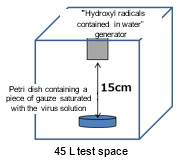
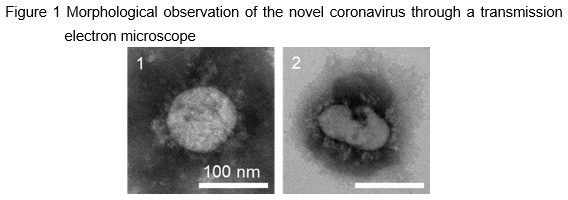
1: Novel coronavirus sample group not exposed to "hydroxyl radicals contained in water"
2: Novel coronavirus sample group exposed to "hydroxyl radicals contained in water"
Morphological distortion (suggesting damage to the envelope) was observed in the sample group exposed to "hydroxyl radicals contained in water"
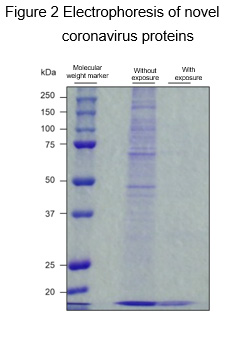
A decrease in the amount of proteins was observed in the "hydroxyl radicals contained in water"-exposed sample group compared to the one without exposure.
* Stained blue when proteins are present.
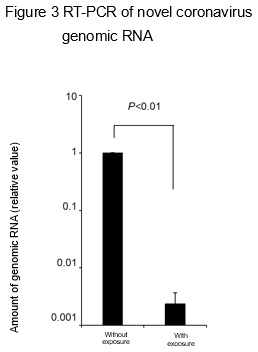
A significant decrease in the amount of genomic RNA was observed in the "hydroxyl radicals contained in water"-exposed sample group compared to the one without exposure.

(Figures 1, 2, and 3 show the effects of "hydroxyl radicals contained in water" on the lipid bilayer membrane (envelope), proteins, and RNA, respectively.)

Measured the amounts of genomic RNA and viral proteins in a state where viruses were bound to cells
Decreases in both amounts were observed in the sample group exposed to "hydroxyl radicals contained in water".
"hydroxyl radicals contained in water" does not target specific molecules or structures of viruses, but damages viruses by acting at multiple levels on the lipid bilayer membrane, proteins, and genomic RNA that make up viruses. Viruses damaged by exposure to "hydroxyl radicals contained in water" lose their ability to bind to host cell receptors, thereby becoming less infectious. These series of phenomena are considered to be part of the mechanism of how the novel coronavirus is inactivated by "hydroxyl radicals contained in water".(Fig.6)
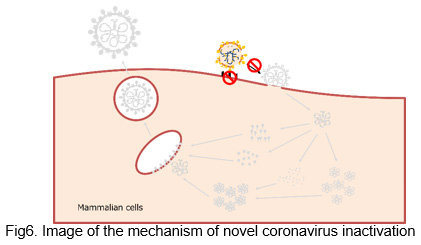
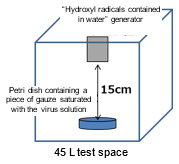
[Measurement of the infection titer]
|
Subjects |
Time |
Virus inhibition rate |
|---|---|---|
|
Novel coronavirus Omicron strain BA.5 |
2 hours |
99.9% |
[Observation of the spread of infection to cells]
Vero cells*5 were inoculated with a novel coronavirus that had been exposed to "hydroxyl radicals contained in water" and one without exposure, respectively. After waiting for approximately 7 hours for the conditions of the cells to stabilize, time-lapse imaging was taken with an interval of 10 minutes.
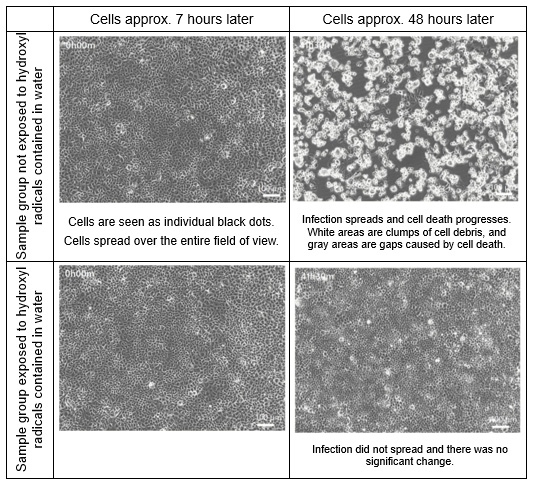
"Hydroxyl radicals contained in water", which is approximately 5 to 20 nm in size and contains OH radicals, is generated by cooling the atomizing electrode with a Peltier element; producing water through the condensation of moisture in the air; and applying a high voltage between the atomizing electrode and the counter electrode.

*1 As ion emission air purification technology (Panasonic data as of June 8, 2022)
*2 [Press Release] Verification of inhibitory effect of hydroxyl radicals contained in water (nano-sized electrostatic atomized water particle) on the novel coronavirus (SARS-CoV-2) (July 2020)
*3 [Press Release] Panasonic Announces Verification of Inhibitory Effect of Hydroxyl Radicals Contained in Water (Nano-Sized Electrostatic Atomized Water Particle) on 4 novel Coronavirus (SARS-CoV-2) Variants (November 2021)
Since the virus infection titer of the new coronavirus and the four variants showed the same decreasing trend regardless of the strain, an expert suggested that the "hydroxyl radicals contained in water" technology does not affect the inactivation effect of viral mutations caused by some amino acid substitutions, and that the same results can be expected for variants that may appear in the future if tests are conducted under the same conditions of a 45 L space.
*4 [Press Release] World First Verified Inhibitory Effect of Hydroxyl Radicals Contained in Water (Nano-Sized Electrostatic Atomized Water Particle) on Adhered Novel Coronavirus in a 24 m3 Test Space (March 2022)
*5 Host cells used to culture novel coronaviruses
The content in this website is accurate at the time of publication but may be subject to change without notice.
Please note therefore that these documents may not always contain the most up-to-date information.
Please note that German, Spanish and Chinese versions are machine translations, so the quality and accuracy may vary.